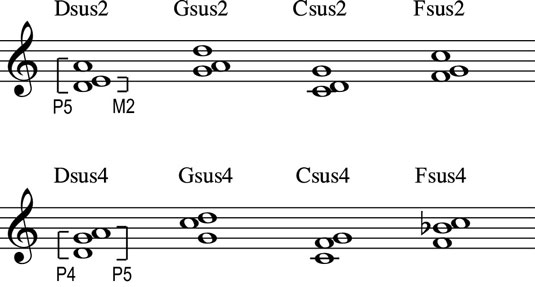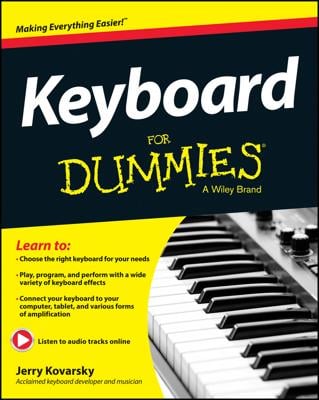You can build the chords you play on the piano yourself. You start with a root note, the lowest note of the chord, then stack notes on top in intervals to make the type of chord you want, whether that’s the popular major and minor chords or the less common augmented, diminished, and suspended chords.
Use fingers 1, 3, and 5 to play most chords — certainly major and minor chords. If you’re playing left-hand chords, start with the pinky finger of your left hand (LH 5) on the root note. For right-hand chords, play the root note with RH 1 — your thumb.
Starting out with major chords
Major chords are perhaps the most frequently used, most familiar, and easiest chords to play. It’s a good bet that most folk and popular songs you know have one or two major chords.
You make major chords with the notes and intervals of a major scale. You build a major chord by starting out with a root note and then adding other notes from the desired chord’s scale. For example, if you want to build a G major chord, you play the root note G, and add the third and fifth notes (or third and fifth intervals) from the G major scale on top of the root note.
Major chords are so common that musicians treat them as almost the norm. These chords are named with just the name of the root, and musicians rarely say “major.” Instead, they just say the name of the chord and use a chord symbol written above the staff to indicate the name of the chord.

Branching out with minor chords
Like the major chord, a minor chord is a triad comprised of a root note, a third interval, and a fifth interval. Written as a chord symbol, minor chords get the suffix m, or sometimes min.

Don’t be fooled by the name “minor.” These chords are no smaller or any less important than major chords. They’re simply built on minor scales, rather than on major scales. Minor chords are to major chords as shadow is to light, the yang to the yin.
You can make a minor chord two different ways:
Play the root note, and add the third and fifth notes of the minor scale on top. For example, play A as the root note, and add the third note (C) and fifth note (E) of the A minor scale.
Play a major chord and lower the middle note, or third interval, by one half-step. For example, a C major chord has the notes C-E-G. To play a C minor chord, lower the E to E-flat.
Tweaking the fifth for augmented and diminished chords
By altering the fifth interval of a major or minor chord, you can create two new chord types, both triads. An augmented chord contains a root note, a major third (M3) interval, and an augmented fifth (aug5), which is a perfect fifth (P5) raised one half-step. Think of an augmented chord as simply a major chord with the top note raised one half-step:

When writing the chord symbol, the suffixes for augmented chords include +, aug, and #5.
A diminished chord contains a root note, a minor third (m3) interval, and a diminished fifth (dim5), which is a perfect fifth (P5) interval lowered one half-step:

Note the suffix used to signal a diminished chord in the chord symbol: °. You may also see the suffix dim in the chord symbol, as in Fdim.
You may find it easiest to use fingers 1, 2, and 4 (thumb, index, and ring) for augmented and diminished chords played with the right hand. For the left hand, try 5, 3, and 2 (pinky, middle, and index).
Waiting for resolution: Suspended chords
Another popular type of three-note chord, although it’s technically not a triad, is the suspended chord. The name means “hanging,” and the sound of a suspended chord always leaves you waiting for the next notes or chords.

The two types of suspended chords are the suspended second and the suspended fourth. Because of their abbreviated suffixes, these chords are often referred to as the sus2 and sus4 chords; you see them written as Csus2 or Asus4, for example. To create them:
A sus2 chord is comprised of a root note, a major second (M2) interval, and a perfect fifth (P5) interval.
A sus4 chord has a root note, a perfect fourth (P4), and a P5 interval.
The sus4 is so popular that musicians often just call it the sus chord. So, when the bandleader says to play “a sus chord on beat 1,” that probably means to play a suspended fourth.
Fingering suspended chords is pretty easy. For the right hand, use fingers 1, 2, and 5 for sus2 chords; use fingers 1, 4, and 5 for sus4 chords. For the left hand, use fingers 5, 4, and 1 for sus2 chords; use fingers 5, 2, and 1 for sus4 chords.

